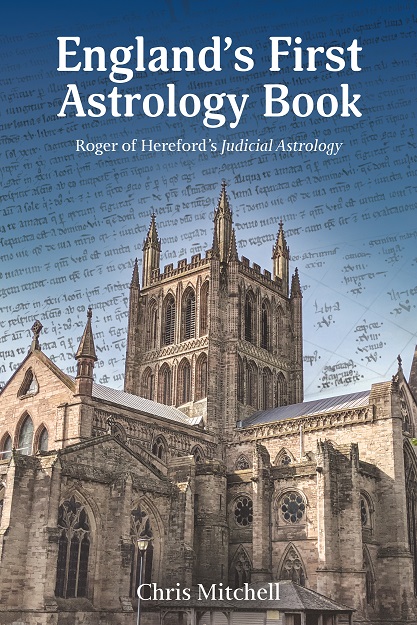
I’m delighted to announce that Almuten Figuris Publications’ first book, England’s First Astrology Book, has now been published.
This book is a translation of a text written by the English scholar Roger of Hereford some time in the 1170s. The twelfth century in England saw a renaissance of astrological, philosophical, and scientific texts translated from Arabic. These texts were the bedrock of what became medieval astrology in Europe from the thirteenth century onwards, and we have these texts thanks to a massive translation effort in the twelfth century.
Many of these texts have been recently translated into English thanks to authors such as Ben Dykes, Charles Burnett, Shlomo Sela, Rob Hand, and Meira Epstein – but one rather neglected area was how astrology was taught and transmitted in this period. That was the topic of my PhD, which involved me in a decade of researching manuscripts of a textbook written by Roger of Hereford. I was alerted to this text by my colleague Dr Bernadette Brady, who discovered a dissertation on it written in 1991 by the scholar Nicholas Whyte specialising in the history of science. Whyte provided an excellent overview of the text, but the purpose of his research was to identify one particular horoscope in the text and not to provide a translation or any astrological analysis. My PhD thesis focused on an astrological analysis of the text, together with its sources.
PhD theses are, by their very nature, rather dry and aimed at a very small academic audience; if the number of people who actually read your thesis can be counted on the fingers of more than one hand, you can consider it a best-seller! I have been guided by Bernadette’s excitement on discovering this work: “Chris – have you seen this dissertation? There was an English astrologer called Roger of Hereford who taught astrology with loads of techniques that most of us have never heard of. You have to do a PhD in this, find out what these techniques were, translate it, and get it out there to astrologers!”
Well, given that I learned my traditional art at Bernadette’s knee, how could I say no? I did my PhD, found out what these techniques were, translated it, and… produced a dry as dust thesis that only three people would read, as required. Having got my PhD, I didn’t feel my work was done; I hadn’t achieved the main point of Bernadette’s enthusiasm: to “get it out there to astrologers”. This, then, was my aim, and it’s finally come to fruition.
I’ve taken Roger’s text; not a trivial task, because his work has never been published. It was handwritten (that’s what the word “manuscript” literally means), in Latin, and copied over several centuries, and each copy ended up in various monasteries initially, then universities, and then a few city libraries. There are 22 of these manuscripts in total, and I tracked them all down and got copies of them. Then I transcribed, as best I could, the sometimes scrawling and almost indecipherable handwriting, and then translated the Latin into English. I don’t pretend to be a Latin scholar, so my translation gives the meat of what Roger said, not a word perfect translation. Even when translated, the techniques need context to make sense of them, so I have laid out the book by giving Roger’s own words, translated into modern English, which stand out in a highlighted box (or in italics in the Kindle version). Each chunk is then followed by my commentary on his text, with numerous worked examples.
Why the title of England’s First Astrology Book? This is the claim that Roger himself made, and it’s not an unreasonable one. When he was writing, the Arabic texts that kickstarted the rediscovery of astrology in twelfth-century Christian Europe were new, and as a teacher he realised that he needed to condense this huge amount of information into a textbook for the kids he was teaching. “Up until now”, Roger tells us, “nobody had collected these universal rules of the astrologers together” and so he was doing this for the first time. In other words, he was writing the first astrology textbook in England. That was about 850 years ago, and yet hardly any astrologers have heard of him or his seminal book. Roger, the brilliant teacher, has been silent for over eight centuries. I hope my book will let him speak again, and bring these techniques to a whole new group of twenty-first-century astrologers!
The book was launched on 24 October 2021, at 11:43 UK time, and is available on Amazon as both a paperback and a Kindle book. You can have a sneak preview of the prelude to the book here – please note that this PDF has pages in colour. The paperback printed book is in black and white, and only the Kindle version has colour images.
11:43? Well, yes – I had to elect a chart, didn’t I?
Using some of Roger’s own rules on the best time to elect a new venture, Mercury, Moon and Venus are all angular. The chart ruler has triplicity rulership and sextiles the ruler of the MC. Mercury rules the ninth house of astrology and is on the MC and in a grand trine with Saturn and the Moon. Mercury is no longer retrograde (which is why I delayed releasing it until 24 October), and sextiles the Ascendant. 11:43 is the hour of Saturn – now, I know most astrologers aren’t fond of Saturn, but he’s my only dignified planet in my natal chart, so I rather like him, and Saturn gets a say in this. Venus is the almuten of my chart, and I’ve called my publishing imprint Almuten Figuris – so I wanted a decent Venus too. She is angular, rules the MC and is received by Jupiter.
